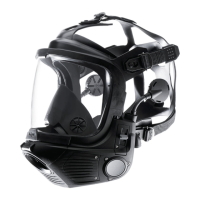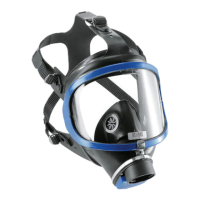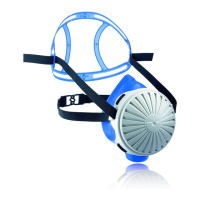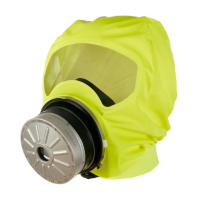3367122 (A3-D-P) Page 5 of 5
11 Special instructions
11.1 Use of an independent air supply (supplied
airline respirator (SAR) connection)
WARNING
Air quality must conform to the statutory requirements.
The time required for the wearer to escape to a safe area must be within
the remaining breathing time of the cylinder, taking into account the
remaining air content in the cylinder and the breathing rate of the wearer.
Independent air supplies must meet the following standards:
● Type-1 gaseous air as defined in: CGA Commodity Specification for
Air, G-71 (grade D or higher).
● NFPA 1989 Standard on Breathing Air Quality for Fire and Emergency
Services Respiratory Protection.
● Air supply pressure: 87 psi to 125 psi.
● Airline hose length: 5 feet to 300 feet (maximum working hose length
must not exceed 12 individual hose lengths).
● Airline flow rate: 550 liters/minute.
● Minimum ambient temperature of operation: -25 °F (-31.7 °C).
Sentinel 7000 alarms and warning signals will operate as normal. The user
interface display will show cylinder pressure when the cylinder valve is
open.
1. Turn on the independent air supply.
2. Connect the independent air supply coupling to the secondary supply
hose (see the UEBSS/SAR connection instructions for use) and
breathe normally.
3. Close the cylinder valve (if the whistle sounds, silence it by taking
several short deep breaths or momentarily operating the lung demand
valve bypass button (Fig J, Item 3).
4. If any air supply problems are encountered, proceed as follows:
a. Open the cylinder valve to return to breathing from the attached
cylinder.
b. Disconnect the independent air supply coupling.
c. Leave the hazardous area by the shortest and safest escape
route, if necessary.
11.2 CBRN use
The Dräger PSS 7000 Series is certified by National Institute for
Occupational Safety and Health (NIOSH), for chemical, biological,
radiological or nuclear (CBRN) use and by the Safety Equipment Institute
(SEI) to meet the requirements of NFPA 1981. Approvals are only valid
when the apparatus is used with compressed-air cylinders approved by
NIOSH. Equipment configurations for CBRN use are detailed in a CBRN
approval table (see CBRN approval table 3367124).
Dräger recommend that a quantitative fit test (QNFT) be performed on the
face mask before use in a CBRN environment. The fit test must be
conducted strictly in accordance with the requirements outlined in the
OSHA Respiratory Protection Standard 29 CFR, Section 1910.134.
11.3 Cautions and limitations
CAUTIONS AND LIMITATIONS
D – Air-line respirators can be used only when the respirators are supplied
with respirable air meeting the requirements of CGA G – 7.1, Grade D
or higher quality.
E – Use only the pressure ranges and hose lengths specified in the
USER'S INSTRUCTIONS.
I – Contains electrical parts that may cause an ignition in flammable or
explosive atmospheres.
J – Failure to properly use and maintain this product could result in injury
or death.
M – All approved respirators shall be selected, fitted, used, and
maintained in accordance with MSHA, OSHA, and other applicable
regulations.
N – Never substitute, modify, add, or omit parts. Use only exact
replacement parts in the configuration as specified by the
manufacturer.
O – Refer to User’s Instructions and/or maintenance manuals for
information on use and maintenance of these respirators.
S – Special or critical user’s Instructions and/or specific use limitations
apply. Refer to User’s Instructions before donning.
CAUTIONS AND LIMITATIONS – CBRN
Q – Use in conjunction with personal protective ensembles that provide
appropriate levels of protection against dermal hazards.
R – Some CBRN agents may not present immediate effects from
exposure, but can result in delayed impairment, illness or death.
T – Direct contact with CBRN agents requires proper handling of the
SCBA after each use and between multiple entries during the same
use. Decontamination and disposal procedures must be followed. If
contaminated with liquid chemical warfare agents, dispose of the
SCBA after decontamination.
U – The respirator should not be used beyond 6 hours after initial
exposure to chemical warfare agents to avoid possibility of agent
permeation.
EBSS – EBSS Activation or engagement of EBSS in either the donor or
receiver mode changes the SCBA use to Escape-Only, approved
service time for either the donor, or the receiver is no longer
applicable. Additional critical cautions and limitations apply. Refer to
the section EBSS in the users' instructions.
11.4 S – Special or critical users' instructions
● The EOSTI alarm set point of this SCBA is 35 ± 2 % of the rated
cylinder pressure. For the activation range see Section 10 (technical
data).
● Minimum ambient temperature of operation: -25 °F (-31.7 °C).
● When used as a combination supplied-air respirator/self-contained
breathing apparatus (SAR/SCBA), not more than 20 percent of the air
supply can be used during entry.
● During supplied air use, the cylinder valve must remain closed. If the
supplied air fails, open the cylinder valve and immediately proceed to
fresh air.
● Supplied air source must meet the following criteria: pressure 87 psi to
125 psi, air flow rate at least 550 liters/minute.
Important Note: If it is decided to exit the working area with the airline
disconnected or, in an emergency, if the air supply fails, breathe
normally and immediately proceed as follows:
● Open the cylinder valve (counterclockwise) slowly, but fully, and
breathe normally.
● Disconnect the hose of the independent air supply from the male
coupling of the airline hose connection. Breathe normally and
immediately leave the hazardous area by the shortest and safest
route.
The remaining duration begins from the time of opening the cylinder
valve and disconnecting the independent air supply. The time
required to allow the wearer to escape to a safe area must be within
the remaining air capacity (volume) of the cylinder taking into
account the breathing rate of the wearer.
● Use of the RIC UAC should be by trained and competent personnel
only.
● The RIC UAC must only be used to recharge a cylinder in emergency
situations as defined in NFPA 1981.
● The RIC UAC filling hose is a component of the NFPA 1981
certification. Only use a filling hose which has been certified to
NFPA 1981 for use in immediately dangerous to life or health (IDLH)
atmospheres.
● Can not use the RIC UAC connection for second person (UEBSS).
● Can not use the RIC UAC to transfer air from one compressed-air
breathing apparatus to another.
● Do not allow oil, grease or other contaminants to contact the RIC UAC
connection.
● Do not attempt to disassemble or repair the RIC UAC connection.
● Caution: The secondary air supply pressure to the RIC UAC must not
exceed maximum rated working pressure of the cylinder(s) being filled.
● Caution: If the pressure relief valve of the RIC UAC is activated, the
SCBA must be returned to the nearest Dräger branch or agent.
● Caution: If a leak is detected while refilling in a contaminated or
oxygen-deficient gaseous atmosphere, stop refilling and immediately
leave the hazardous area.
11.5 UEBSS – Special or critical users' instructions
Safety Warning: Use of a Universal Emergency Breathing Support
System (UEBSS) must comply with NIOSH and NFPA 1981
requirements.
Refer also to the instructions for use for the UEBSS.
● UEBSS may not be engaged or activated in donor mode after the
donor End-of-Service-Time-Indicator (EOSTI) has activated.
● Users must be fully trained in the operation of UEBSS in accordance
with a training program conforming to the requirements of NFPA
Standards 1404, Fire Service Respiratory Protection Training and
1500, Fire Department Occupational Safety and Health Program.
● Simultaneous connection of more than two users (one donor, and one
receiver) is not permitted.
● Immediately after the UEBSS connection has been completed, the
cylinder valve of the receiving SCBA shall be closed.
The time required to allow the wearers to escape to a safe area must
be within the remaining air capacity (volume) of the cylinder taking
into account the breathing rate of the wearers.
12 Warranty information
Unless otherwise agreed between Dräger and the customer, the following
shall apply in the event of defects of the product in material or
workmanship: The customer shall contact the company where he bought
the product ("Seller"). The warranty conditions agreed between the
customer and the Seller shall apply. The product must be used in strict
accordance with the instructions for use. Any use disregarding the
instructions for use may void warranty.
13 Contact details
Any issues with the equipment, including damage, malfunction, or failure
of the breathing apparatus that may present a hazard to the user should be
reported to Dräger US Customer Service – Phone 1-800-437-2437.
Contact with the certification organizations may be reached at:
● NIOSH, NPPTL – Phone 1-412-386-4000
● SEI (NFPA) – 1307 Dolley Madison Blvd, Suite 3A, McLean, VA
22101, Phone 1-703-442-5732
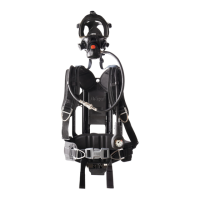
